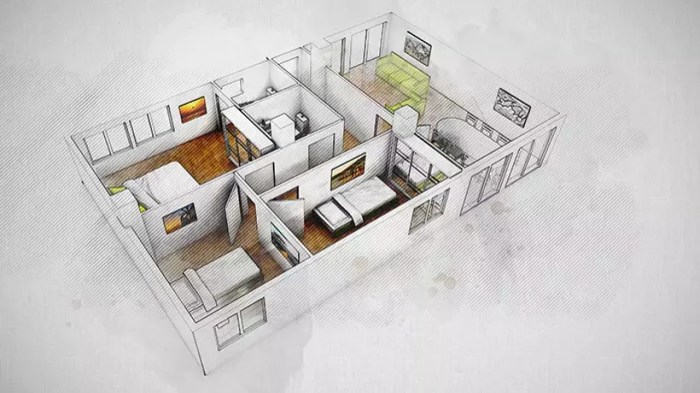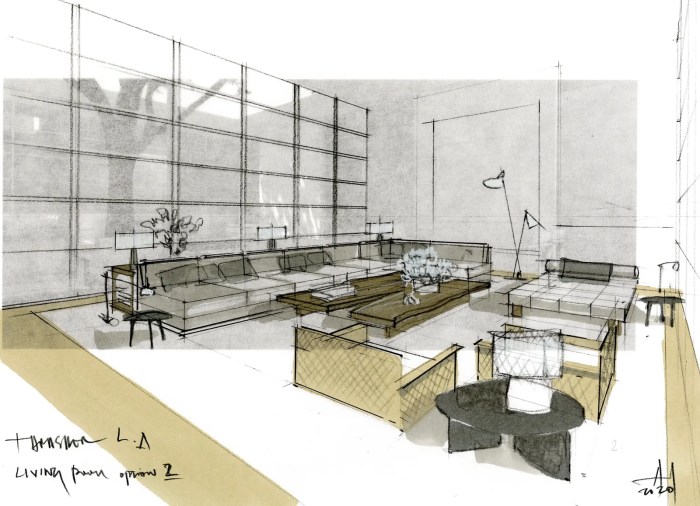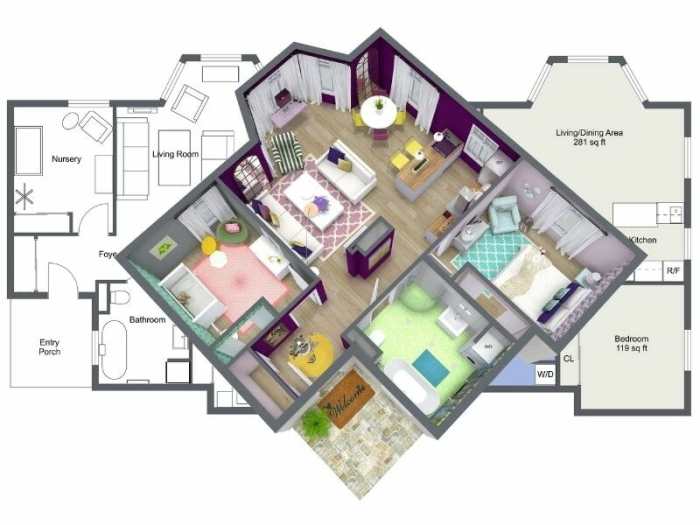Architecture Design: House Interior Drawing
Architecture design house interior drawing – Architecture Design: House Interior Drawing, a captivating blend of artistry and practicality, encompasses the intricate process of translating architectural visions into stunning and functional living spaces. From the initial conceptualization of a home’s layout to the meticulous detailing of every interior element, this field involves a profound understanding of design principles, spatial relationships, and the art of creating environments that inspire and delight.
Interior design plays a crucial role in enhancing architectural concepts, transforming empty spaces into inviting and functional havens. By harmonizing aesthetics with functionality, interior designers create environments that cater to the specific needs and desires of their clients, ensuring a seamless flow between form and function.
Key Principles of Architectural Design for Houses

Designing a house involves a blend of functionality, aesthetics, and technical considerations. Architects adhere to key principles to ensure a comfortable, visually appealing, and structurally sound living space. These principles guide the design process, from initial planning to the final execution.
Functionality and Usability, Architecture design house interior drawing
Functionality and usability are paramount in residential architecture. The design should prioritize the needs of the inhabitants, ensuring a comfortable and efficient living experience. This involves optimizing space utilization, creating intuitive layouts, and incorporating features that enhance daily life.
- Circulation:The flow of movement within a house is crucial. Designers aim to create clear pathways, minimizing unnecessary steps and ensuring smooth transitions between rooms. This can be achieved through well-placed doorways, hallways, and staircases.
- Natural Light:Maximizing natural light is a key aspect of functionality. Large windows, skylights, and strategically placed openings allow sunlight to penetrate the interior, creating a bright and welcoming atmosphere. This not only improves mood but also reduces the need for artificial lighting, contributing to energy efficiency.
- Ventilation:Adequate ventilation is essential for maintaining a healthy indoor environment. Cross-ventilation, achieved through windows on opposite sides of a room, promotes air circulation and reduces humidity. This can be further enhanced with strategically placed vents and fans.
- Storage:Efficient storage solutions are vital for maintaining a tidy and organized home. Built-in cabinets, closets, and other storage features are integrated into the design to maximize space utilization and minimize clutter.
Aesthetics and Style
The aesthetic appeal of a house is crucial, as it reflects the homeowner’s personality and taste. Architects utilize various design elements to create visually pleasing and harmonious spaces.
- Form and Massing:The overall shape and volume of a house contribute significantly to its aesthetic appeal. Architects explore different geometric forms, such as cubes, spheres, and cones, to create visually interesting structures. Massing refers to the distribution of these forms, influencing the building’s silhouette and its relationship to the surrounding environment.
- Balance and Proportion:Balance refers to the visual equilibrium of a design, ensuring that elements are distributed harmoniously. Proportion deals with the relative size and scale of different parts of the structure, creating a visually pleasing and cohesive whole.
- Materials and Finishes:The choice of materials and finishes plays a crucial role in defining the aesthetic character of a house. Different materials, such as wood, stone, brick, and glass, possess unique visual qualities and textures. These materials are carefully selected to create a desired aesthetic and to complement the overall design concept.
- Color and Texture:Color and texture are powerful tools for creating visual interest and defining the mood of a space. Architects use color palettes and textural variations to enhance the overall aesthetic appeal of a house. For instance, warm colors can create a cozy and inviting atmosphere, while cool colors can evoke a sense of calmness and tranquility.
Structural Integrity and Safety
Beyond aesthetics and functionality, structural integrity and safety are paramount considerations in residential architecture. Buildings must be designed to withstand various environmental factors and ensure the safety of its occupants.
- Foundation:The foundation is the base of a house, providing support and stability. Architects carefully design foundations based on the soil conditions, climate, and the weight of the structure. This ensures that the building remains stable and safe throughout its lifespan.
- Framing:The framing system provides the structural skeleton of a house, supporting the walls, roof, and floors. Architects select appropriate framing materials, such as wood or steel, based on the building’s size, design, and local building codes. This ensures that the structure can withstand loads and resist seismic forces.
- Roofing:The roof protects the house from the elements and plays a vital role in its structural integrity. Architects design roofs considering factors such as climate, slope, and material choices. This ensures that the roof can effectively shed water, snow, and wind loads, while also providing thermal insulation and aesthetic appeal.
- Fire Safety:Fire safety is a crucial aspect of residential design. Architects incorporate features such as fire-resistant materials, smoke detectors, and fire suppression systems to minimize the risk of fire hazards. This ensures the safety of the occupants and protects the structure from damage.
Elements of Interior Drawing

Interior drawing is the art of representing the interior spaces of a building. It is a crucial aspect of interior design, as it allows designers to communicate their ideas to clients, contractors, and other stakeholders. Effective interior drawings help visualize the space, understand the layout, and explore different design options.
Linework
Linework is the foundation of interior drawing. It is used to define the shape, size, and form of objects and spaces. Different types of lines have distinct meanings and applications:
- Artikel Lines:Define the outer edges of objects and spaces.
- Construction Lines:Used for initial sketching and planning.
- Dimension Lines:Indicate the size and measurements of objects and spaces.
- Hatching Lines:Used to represent different materials and textures.
The thickness, weight, and style of lines can convey different levels of detail and emphasis.
Perspective
Perspective is the representation of three-dimensional objects on a two-dimensional surface. It creates the illusion of depth and realism in interior drawings. There are several types of perspective:
- One-Point Perspective:Used for objects viewed directly from the front or back, with parallel lines converging at a single vanishing point.
- Two-Point Perspective:Used for objects viewed from an angle, with parallel lines converging at two vanishing points.
- Three-Point Perspective:Used for objects viewed from a high or low angle, with parallel lines converging at three vanishing points.
Perspective is essential for creating accurate and realistic interior drawings that convey the spatial relationships and proportions of a room.
Color
Color plays a crucial role in interior design and drawing. It influences mood, atmosphere, and the overall aesthetic of a space.
- Color Theory:Understanding color relationships, such as complementary, analogous, and triadic colors, is essential for creating harmonious and balanced interior designs.
- Color Rendering:Interior drawings often use color to represent different materials, finishes, and furniture. Color rendering can be achieved through various techniques, such as hand-painting, digital rendering, or using colored pencils.
Color can enhance the visual impact of interior drawings and communicate the designer’s vision effectively.
Drawing Techniques
There are various drawing techniques that interior designers can use to create their drawings:
- Hand Drawing:Traditional hand-drawing techniques using pencils, pens, and markers allow for a personal touch and creative freedom. These drawings can be rendered in various styles, from simple line drawings to detailed perspective sketches.
- Computer-Aided Design (CAD):CAD software enables precise and detailed drawings, including floor plans, elevations, and 3D models. CAD drawings are highly accurate and can be easily modified and shared.
- Digital Rendering:Digital rendering software allows designers to create photorealistic images of interior spaces. These renderings are highly realistic and can help clients visualize the final design.
The choice of drawing technique depends on the designer’s preference, the project’s requirements, and the level of detail needed.
Floor Plan
A floor plan is a top-view drawing that shows the layout of a room or building. It is a fundamental drawing in interior design, as it provides a clear understanding of the spatial arrangement, dimensions, and relationships between different elements.
Step-by-Step Guide to Drawing a Basic Floor Plan
- Define the Room Dimensions:Determine the length and width of the room using accurate measurements.
- Draw the Room Artikel:Use a ruler and pencil to draw the outer walls of the room to scale.
- Add Interior Walls and Partitions:Draw any internal walls or partitions, indicating their thickness and position.
- Mark Doors and Windows:Draw the location and size of doors and windows, using symbols to represent them.
- Add Furniture and Fixtures:Draw the location and size of furniture, appliances, and other fixtures, using appropriate symbols.
- Label Important Features:Add labels to identify key elements, such as rooms, doors, windows, and fixtures.
- Add Dimensions:Include dimensions for walls, doors, windows, and other important elements.
- Clean Up the Drawing:Erase unnecessary lines and refine the drawing for clarity and accuracy.
Elevation
An elevation drawing is a side view of a room or building, showing the height and arrangement of walls, doors, windows, and other features. It provides a visual representation of the vertical elements of a space.
Step-by-Step Guide to Drawing a Basic Elevation
- Choose a Wall:Select the wall you want to represent in the elevation drawing.
- Draw the Wall Artikel:Draw the vertical and horizontal lines that define the wall’s height and width.
- Add Doors and Windows:Draw the location and size of doors and windows, using appropriate symbols.
- Include Trim and Moulding:Add details such as baseboards, crown moulding, and window trim.
- Add Furniture and Fixtures:If necessary, draw the location and size of furniture and fixtures that are visible from the chosen wall.
- Label Important Features:Add labels to identify key elements, such as doors, windows, and fixtures.
- Add Dimensions:Include dimensions for the wall’s height, width, and other important elements.
- Clean Up the Drawing:Erase unnecessary lines and refine the drawing for clarity and accuracy.
Last Point: Architecture Design House Interior Drawing

Mastering the art of architecture design and house interior drawing requires a deep understanding of design principles, a keen eye for detail, and a passion for creating spaces that inspire and enhance the human experience. By skillfully integrating architectural concepts with interior design elements, professionals can transform dreams into reality, crafting homes that are not only beautiful but also functional, comfortable, and sustainable.
Top FAQs
What are the most important factors to consider when designing a house interior?
The most important factors include functionality, aesthetics, budget, lifestyle, and personal preferences. It’s crucial to create a space that meets the needs of the occupants while reflecting their individual tastes and style.
How can I learn more about interior design and house interior drawing?
There are numerous resources available, including online courses, design schools, books, and professional organizations. You can also find inspiration from design magazines, blogs, and social media platforms.
What software is commonly used for house interior drawing?
Popular software options include AutoCAD, SketchUp, Revit, and 3ds Max. These programs allow for precise 2D and 3D modeling, rendering, and visualization of interior spaces.



